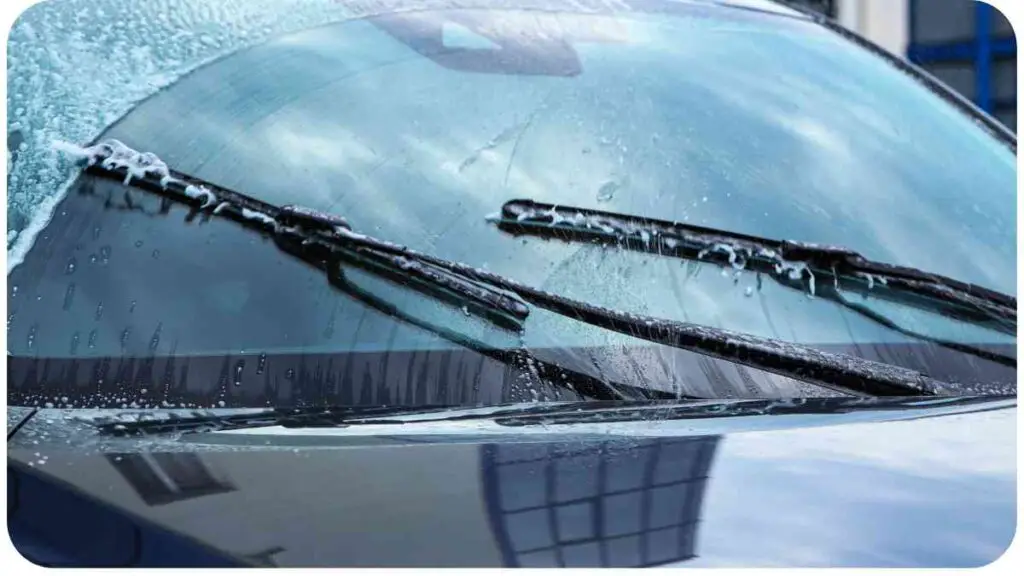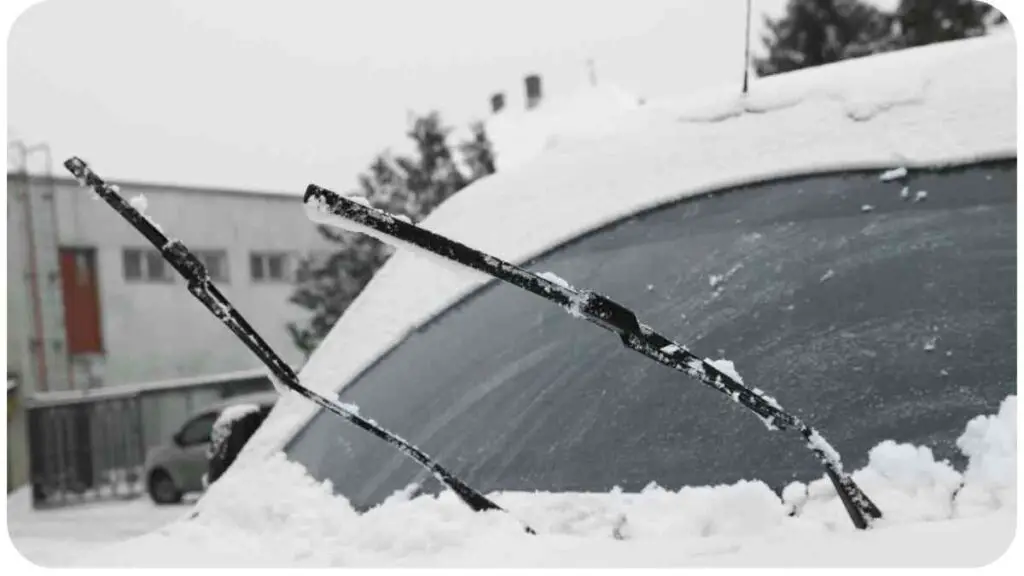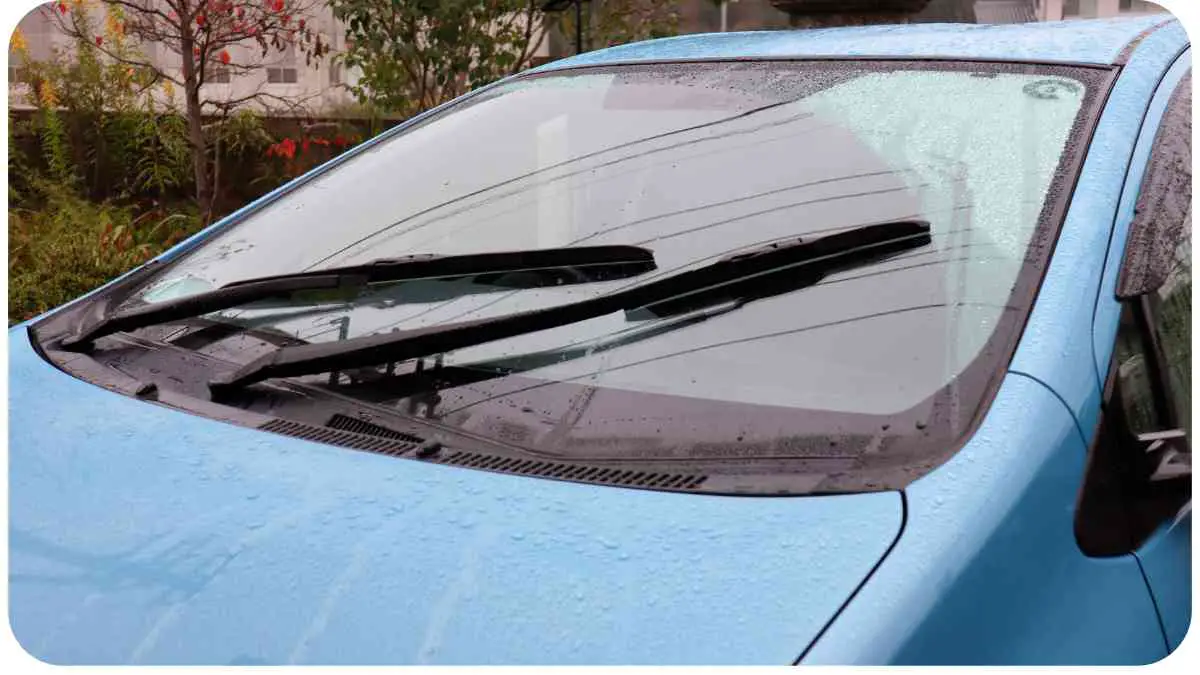Welcome to our guide on resolving the frustrating issue of streaky windshield wipers. We understand the annoyance caused by impaired visibility and the struggle to maintain clear vision during rainy or snowy weather.
In this article, we will explore the reasons behind streaky wipers and provide simple adjustments to address the problem effectively. Whether you’re a seasoned driver or a novice, this guide will help you keep your windshield crystal clear for a safer and more enjoyable driving experience.
| Takeaways |
| Proper maintenance of windshield wipers is essential for clear visibility and safe driving. |
| Adjusting the wiper blades and ensuring proper alignment can help prevent streaking. |
| Cleaning the wiper blades regularly removes dirt and debris buildup, improving their performance. |
| If adjusting and cleaning do not fix the streaking issue, it may be time to replace the wiper blades. |
| Choosing the right wiper blades, considering factors like size and type, is crucial for optimal performance. |
| Regularly inspecting and maintaining the wiper arms, cleaning the windshield, and checking the wiper fluid reservoir contribute to better wiper performance. |
| Expert tips, such as adjusting wiper speed in extreme weather conditions and removing ice and snow from the blades, can enhance their effectiveness. |
| Seeking professional help may be necessary if streaking persists or if significant damage is present. |
| Further reading can provide more in-depth information on preventing streaky wipers and resolving common windshield wiper problems. |
| Frequently asked questions address key concerns regarding wiper blade replacement, cleaning, compatibility, and troubleshooting. |
2. Understanding the Importance of Windshield Wipers
Before we dive into the reasons behind streaky windshield wipers, let’s take a moment to appreciate the vital role they play in ensuring driver safety. Windshield wipers are essential for a clear field of vision, especially during adverse weather conditions. When rain, snow, dirt, or debris accumulate on the windshield, wiper blades sweep across the glass, providing the driver with a clear view of the road ahead.
Cold weather demands special care for your vehicle. Ensure safety with essential tips, such as winter tire maintenance and checking antifreeze levels. Stay ahead of the seasonal challenges.
3. Common Causes of Streaky Windshield Wipers

Streaky windshield wipers can be attributed to a few common causes. It’s important to identify the underlying issue to effectively resolve the problem. Let’s take a look at some culprits that may be responsible for streaky wipers:
- Worn-out wiper blades: Over time, wiper blades deteriorate due to constant exposure to the elements. As the rubber becomes worn or damaged, it can cause streaks on the windshield.
- Dirty wiper blades: The accumulation of dirt, grime, and debris on the wiper blades can hinder their performance, leading to streaks.
- Improperly adjusted wiper blades: If the wiper blades are not correctly aligned, they might not make optimal contact with the windshield, resulting in streaks.
- Uneven pressure distribution: Uneven pressure can occur if the wiper arms are bent or damaged, leading to inconsistent contact between the wiper blades and the windshield.
4. How to Identify Streaky Windshield Wipers
To determine if your windshield wipers are leaving streaks, look out for the following signs:
- Visual inspection: Carefully examine the windshield after using the wipers. If you notice streaks, smudges, or areas that are not properly cleared, it’s a clear indication of streaky wipers.
- Unusual noises: While operating the wipers, listen for any unusual sounds. If you hear scraping, skipping, or chattering noises, it could signal issues with the wiper blades.
- Decreased visibility: If you find your visibility is compromised even after using the wipers, it’s likely that streaky blades are the culprit.
Once you’ve confirmed the presence of streaks, it’s time to implement some simple adjustments to rectify the issue.
Smooth rides begin with proper care. Regularly check fluids, belts, and engine components. Following these tips ensures your vehicle runs efficiently, preventing breakdowns and extending its lifespan.
5. Quick Fixes for Streaky Windshield Wipers
Adjusting the Wiper Blades
One of the first steps in resolving streaky wiper issues is to ensure proper alignment and contact of the wiper blades with the windshield. Here’s how you can adjust the wiper blades:
- Lift the wiper arm away from the windshield, being careful not to let it snap back onto the glass.
- Locate the small tab or release lever on the wiper blade joint.
- Gently push or slide the tab or lever to release the blade from its attachment point.
- Adjust the blade’s position so that it makes even and consistent contact across the windshield. 5. Carefully align the blade with the contour of the windshield by gently bending the wiper arm, if necessary.
- Once properly aligned, push the blade back into the attachment point until you hear a click or feel it securely in place.
- Lower the wiper arm back down onto the windshield.
Cleaning the Wiper Blades
Another common culprit of streaky wipers is dirt and debris buildup on the blades. Cleaning them can help restore their performance. Follow these steps to clean your wiper blades:
- Lift the wiper blades away from the windshield, as you would when replacing them.
- Take a clean cloth or paper towel and moisten it with warm, soapy water.
- Wipe the cloth along the length of the wiper blade, applying gentle pressure to remove dirt, grime, and debris.
- Repeat this process on both sides of the blade until it’s free of buildup.
- Once clean, lower the wiper blades back onto the windshield.
Get answers to common car maintenance queries, covering topics like oil change intervals and tire rotation frequency. Clear your doubts and enhance your understanding of essential vehicle upkeep practices.
Replacing the Wiper Blades
If adjusting and cleaning the wiper blades don’t alleviate the streaking issue, it may be time to replace them. Over time, wiper blades wear out and lose their effectiveness. Here’s how you can replace them:
- Lift the wiper arm away from the windshield.
- Locate the small tab or release lever on the wiper blade joint.
- Push or slide the tab or lever to release the blade from its attachment point.
- Remove the old wiper blade by pulling it straight down, away from the arm.
- Align the new wiper blade with the arm and slide it into the attachment point until it clicks or securely locks in place.
- Gently lower the wiper arm back onto the windshield.
By utilizing these quick fixes, you can effectively address streaky windshield wipers and maintain clear visibility on the road.
6. Proper Maintenance for Optimal Wiper Performance

While adjusting, cleaning, and replacing wiper blades can solve streaking issues, proper maintenance is crucial for long-term optimal performance. Here are some essential maintenance practices:
Discover expert-recommended tips to maintain your vehicle’s health. From choosing the right motor oil to inspecting brakes, these insights empower you to proactively care for your car and ensure optimal performance.
Cleaning the Windshield
Regularly cleaning your windshield helps prevent the accumulation of dirt, grime, and debris, which can affect the performance of your wiper blades. Consider the following steps to maintain a clean windshield:
- Use a glass cleaner designed for automotive use.
- Spray the cleaner onto the windshield’s surface.
- Wipe the windshield using a lint-free microfiber cloth or paper towels.
- Pay close attention to areas where streaks or residue may be present.
- Perform this cleaning routine on a regular basis to keep your windshield clear.
Inspecting the Wiper Arms
The wiper arms and their attachments play a crucial role in ensuring proper wiper blade contact with the windshield. Conduct routine inspections to ensure their optimal functioning:
- Carefully examine the wiper arms for signs of bending, corrosion, or damage.
- Check the attachment points where the wiper blades connect to the arms for any signs of looseness or wear.
- If you notice any issues, such as bent arms or loose connections, consider seeking professional assistance for repairs or replacements.
Uncover intriguing and practical facts about car maintenance. Learn about the impact of regular maintenance on fuel efficiency, engine longevity, and overall vehicle reliability. Be informed before your next service appointment.
Checking the Wiper Fluid Reservoir
Having an ample supply of windshield wiper fluid is essential for effective wiper performance. Regularly monitor the wiper fluid reservoir and follow these steps to check its level:
- Locate the wiper fluid reservoir under the hood of your vehicle.
- Remove the cap and visually inspect the fluid level.
- If the fluid is low, fill the reservoir with an appropriate windshield wiper fluid recommended by your vehicle’s manufacturer.
- Avoid using plain water as it may freeze during cold weather or leave residue on the windshield.
Proper maintenance practices help extend the lifespan of your wiper blades and ensure their optimal functionality when you need them most.
7. Choosing the Right Windshield Wiper Blades
When it comes to selecting windshield wiper blades, various factors should be considered to make an informed decision. Here’s what you need to know:
Types of Wiper Blades
There are primarily three types of wiper blades available for most vehicles:
- Traditional Bracket Blades: These are the standard wiper blades with a metal frame and rubber blade. They are economical and widely used.
- Beam Blades: Also known as flat blades, these feature a curved design that provides better contact with the windshield. They are generally more expensive than traditional blades but provide improved performance.
- Hybrid Blades: These blades combine the best features of traditional and beam blades, providing durability, flexibility, and improved wiping performance.
Factors to Consider When Selecting Wiper Blades
When choosing wiper blades, take the following factors into account:
- Size: Wiper blades come in various lengths, so ensure you select the correct size for your specific vehicle make and model. Refer to your vehicle’s owner’s manual or consult a professional to determine the appropriate size.
- Compatibility: Ensure that the wiper blades you choose are compatible with your vehicle’s wiper arm type. Some vehicles require specific wiper blade attachments, so it’s important to check for compatibility.
- Quality: Invest in high-quality wiper blades that are known for their durability and performance. Look for blades that are made from premium materials and have positive customer reviews.
- Climate Considerations: If you live in an area with extreme weather conditions, such as heavy rain or snow, consider wiper blades specifically designed for those conditions. Look for blades with special features like advanced rubber compounds or built-in spoilers for improved performance in challenging weather.
By considering these factors, you can select wiper blades that provide optimal performance and longevity, ensuring clear visibility during any weather conditions.
8. Expert Tips and Tricks for a Clear Windshield
Here are some additional expert tips and tricks to help you maintain a clear windshield and maximize the performance of your wiper blades:
Avoiding Streaks in Extreme Weather Conditions
- During heavy rain or snowfall, adjust your wiper speed to match the intensity of the weather. Higher speeds may lead to streaks or cause the blades to skip.
- If your windshield is iced over, use a scraper or de-icer to remove the ice before activating the wipers. Using the wipers on ice can damage the blades and hinder their performance.
Removing Ice and Snow from Windshield Wipers
- Before operating the windshield wipers in snowy conditions, clear away any accumulated snow or ice from the blades. This ensures smooth and effective movement.
- Lift the wiper arms away from the windshield and gently tap them to dislodge any ice or snow. Additionally, you can use warm water or defroster settings to help melt stubborn ice.
Preserving Wiper Blades During Summer Months
- During hot summer months, park your vehicle in shaded areas or use windshield sun shades to minimize the heat exposure on the wiper blades. Excessive heat can degrade rubber and reduce their lifespan.
- Regularly clean your windshield to remove bugs, tree sap, and other debris that can accumulate during summer. These substances can impact the performance of the wiper blades and cause streaking.
By following these expert tips, you can maintain optimal wiper blade performance and ensure a clear windshield in various weather conditions.
9. When to Seek Professional Help
While most streaky wiper issues can be resolved through simple adjustments and maintenance, there may be instances where professional assistance is required. Consider seeking professional help in the following scenarios:
- If the streaking issue persists despite implementing the quick fixes and maintenance practices mentioned earlier.
- If you notice significant damage to the wiper arms, connections, or other components that are beyond your ability to repair.
- If you are unsure about the correct size or type of wiper blades that are compatible with your vehicle.
Professional technicians have the expertise and specialized equipment to diagnose and resolve complex wiper issues, ensuring optimal performance and a clear windshield.
10. Frequently Asked Questions (FAQs)
How Often Should I Replace Windshield Wiper Blades?
It is recommended to replace your windshield wiper blades every 6 to 12 months, depending on their condition and usage. However, if you notice streaking, smudging, or other signs of reduced performance, it’s best to replace them sooner.
Can Streaky Windshield Wipers Damage My Windshield?
Yes, streaky wipers that leave residue or create uneven pressure on the windshield can potentially damage the glass over time. It’s important to address streaking issues promptly to protect your windshield.
What Can Cause Uneven Wiper Blade Wear?
Uneven wiper blade wear can be caused by factors such as improper alignment, damaged wiper arms, and irregular usage patterns. Regular maintenance and prompt replacement of worn-out blades can help prevent uneven wear.
Are OEM Wiper Blades Always the Best Choice?
Original Equipment Manufacturer (OEM) wiper blades are specifically designed for your vehicle make and model. While they are often a reliable choice, aftermarket wiper blades from reputable brands can also provide excellent performance and durability. Consider factors such as price, quality, and customer reviews when deciding on wiper blades.
11. Conclusion
Maintaining clear visibility through proper windshield wiper care is essential for safe and comfortable driving. By understanding the common causes of streaky wipers and implementing simple adjustments, such as adjusting, cleaning, or replacing the blades, you can overcome this common issue.
Regular maintenance and selecting high-quality wiper blades go a long way in ensuring optimal performance. Remember to consider climate conditions, inspect your wiper arms, and check wiper fluid levels for comprehensive upkeep. By following the expert tips and tricks shared in this article, you
Further Reading
Here are some additional resources you can explore to learn more about windshield wipers and how to prevent streaks:
- Why Do Windshield Wipers Leave Streaks and How to Prevent It: This article explains the common reasons behind streaky windshield wipers and provides preventive measures to avoid this issue. It offers insights into proper maintenance and blade selection.
- Easy Fixes for Annoying Windshield Wiper Problems: This blog post discusses various windshield wiper problems and provides easy solutions to address them. It covers topics like adjusting, cleaning, and replacing wiper blades, as well as other maintenance tips.
- How Do I Stop My Windscreen Wipers from Leaving Streaks: This Quora thread offers insights from users discussing tips and techniques to prevent windshield wipers from leaving streaks. It provides diverse perspectives and suggestions to overcome this issue.
FAQs
Here are some frequently asked questions about preventing streaky windshield wipers and their answers:
How often should I replace windshield wiper blades?
Windshield wiper blades should generally be replaced every 6 to 12 months, or sooner if you notice reduced performance such as streaking or smudging.
Can dirty wiper blades cause streaks?
Yes, dirt and debris buildup on wiper blades can lead to streaks. Regularly cleaning the blades and the windshield can help prevent this issue.
Are there different types of wiper blade attachments?
Yes, there are different types of wiper blade attachments, such as hook-style, side-pin, and bayonet-style. It’s important to ensure that the wiper blades you choose are compatible with your vehicle’s attachment type.
How do I clean my windshield wipers?
To clean your windshield wipers, you can use warm, soapy water and a clean cloth. Wipe the length of the blades to remove dirt, grime, and debris. Make sure to clean both sides of the blade.
What should I do if my wiper blades skip or chatter?
If your wiper blades skip or chatter across the windshield, it may indicate that they need to be replaced. Damaged or worn-out blades can cause this issue, and replacing them should help resolve the skipping problem.

Hello friends. My name is Hellen James and I’m here to help you make good decisions when it comes to buying, selling, and maintaining your vehicles.


